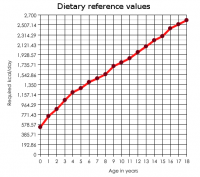User:KVDP/Appropriate nutrition manual 3
Types[edit | edit source]

Make-up of food types needs to be imbedded from my previous writings
Quantities[edit | edit source]
The quantity required differs per person. This, since each person has a different genetic makeup (or Basal Metabolic Rate) (making them larger, smaller, ...) and depending on the function they have in society, they may also have different Physical Activity Levels.
Formula[edit | edit source]
We use the Harris-Benedict equation, which goes as follows:
- Men: BMR = 66 + (13.7 X weight in kg) + (5 X height in cm) - (6.8 X age in years)
- Women: BMR = 655 + (9.6 X weight in kg) + (1.8 X height in cm) - (4.7 X age in years)
Basal Metabolic Rate[edit | edit source]
Note 1: between 0 and 9 months, the caloric intake actually needs to be added to the pregnant female in question. A close-up of the exact caloric requirements per 3 months are:
- Age in months -- kcal/d:
- 0-3 -- BMR:392,85 x PAL:1,40 = 550 TDEE
- 4-7 -- BMR:464,28 x PAL:1,40 = 650 TDEE
- 7-9 -- BMR:500 x PAL:1,40 = 700 TDEE
Note 2: For the dietary reference values for people with an age above 18, the extra number of years above 18 are multiplied by 6 (average 6,8 and 4,7 of male/female Harris-Benedict formula) and added to the BMR. Thus, older people will generally require a bit more calories than younger people (thus contrary to popular beliefs), but it is likely that the end result will nonetheless be smaller, since older people often become less active, and thus the PAL will generally reduce.
Note 3:
- TDEE means Total Daily Energy Expenditure
- BMR means Basal Metabolic Rate
- PAL means Physical Activity Ratio
Physical Activity Level[edit | edit source]
| Mean activity level[1] | P.A.L. range | Average P.A.L. | Description of activities [2] |
| Sedentary | 1,175-1,375 | 1,2 | No exercise, desk job; reading, watching TV, writing, calculating, playing cards, listening to music |
| Lightly active | 1,375-1,550 | 1,4 | Little exercise, desk job; sewing, knitting, playing piano, cooking, washing up, ironing, writing, calculating, playing cards, dressing, undressing, showering, ... |
| Moderatly active | 1,550-1,725 | 1,6 | Moderate exercise, non-desk job; easy household chores, dusting, cleaning, washing by hand, cooking, hairdressing, playing pool, driving, bowling, general office work. |
| Very active | 1,725-1,900 | 1,8 | Hard exercise, physically more demanding job; vacuuming, making beds, slow walking, cricket, tailoring, shoemaking, electrical, machine tool operating, painting, decorating. |
| Extra active | 1,900-... | 2,0 | Very hard exercise, physically demanding job; Mopping floor, gardening, cleaning windows, playing tennis, sailing, moderate swimming, cycling, slow jogging, moderate walking, playing golf, carpentry, joinery, bricklaying. |
